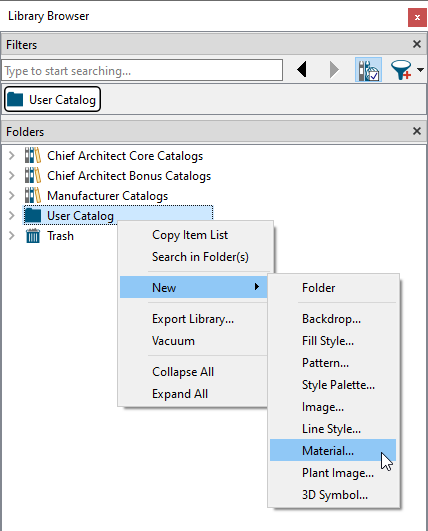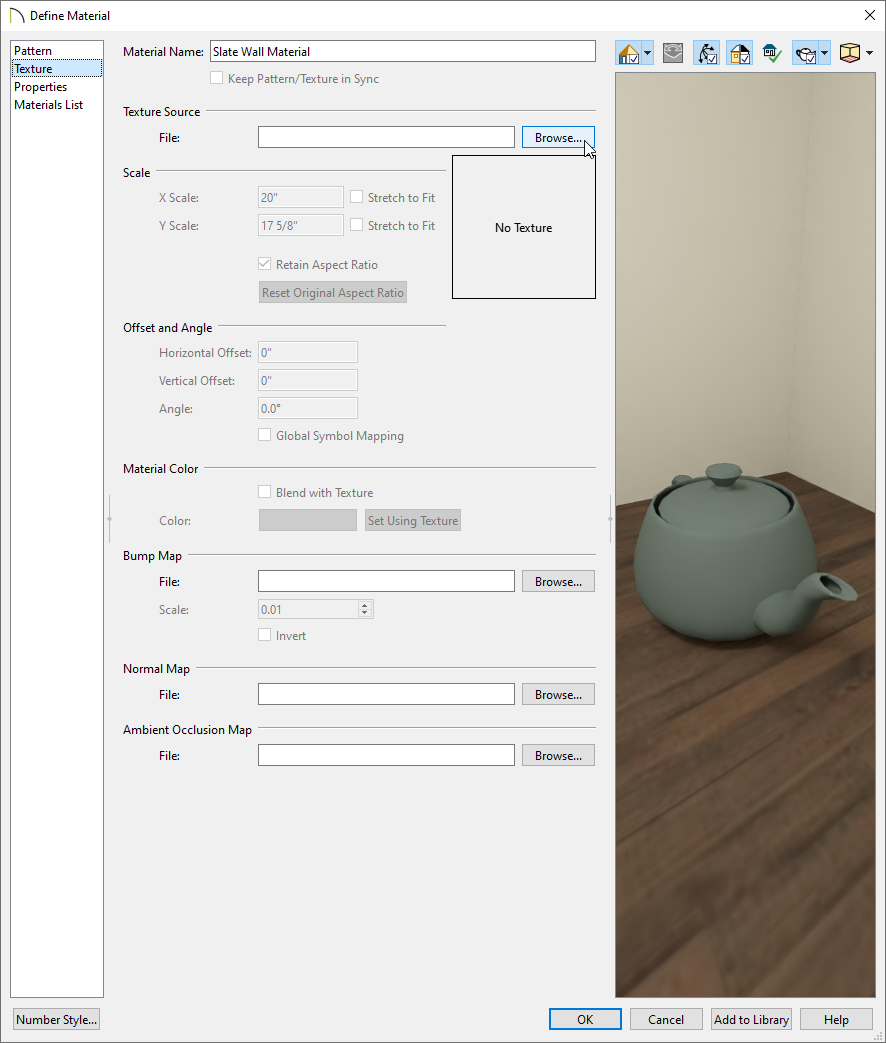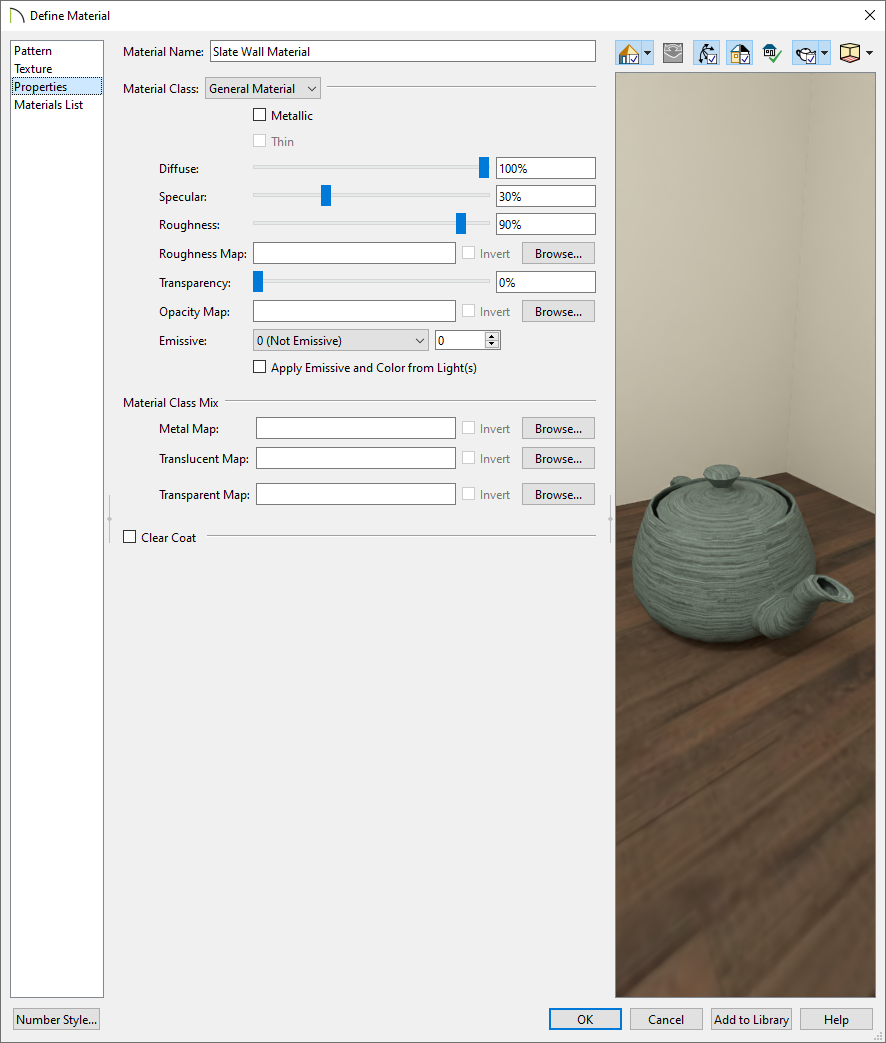The information in this article applies to:

QUESTION
I have an image on my computer that I would like to use in my plan as a material that can be applied to 3D objects. How do I do this?

ANSWER
Materials in Chief Architect have two primary attributes that determine what they look like in 3D views: patterns composed of CAD lines, and textures which are created using image files such as .jpg's or .png's. A new material with both a custom pattern and texture can easily be created in the User Catalog, which is located in the Library Browser.
If you want to import a new material that will be tiled seamlessly across a surface, make sure that the image that will be used will line up accurately to look realistic for 3D camera views.
To create a new material
- If the Library Browser is not already open, navigate to View> Library Browser
 .
.
- Right-click once on the User Catalog folder and select New> Material from the contextual menu that displays.

If you would like to add a new material to a folder or subfolder in your User Catalog, right click on the desired folder and select New> Material.
- The Define Material dialog will open.
The settings on the Pattern panel control how the material will appear in the Vector View, Technical Illustration, and Hand Drawn Line rendering techniques. When the Hand Drawn Lines on Top setting is enabled within the Watercolor rendering technique, pattern lines are also used.


- Specify a Material Name.
- If desired, choose a Material Color and a Pattern Type using either the drop-down menu or clicking the Library button.
- The settings on the Texture panel control the appearance of the material in the Standard, Physically Based, Watercolor, and Duotone rendering techniques, as well as CPU Ray Trace views.

- Click the Browse button next to Texture Source File and browse your computer for the image that you would like to use as a custom material.
- Once it's specified, adjust the Scale and Offset and Angle settings to your liking.
For more information on each of the options listed here, click on the Help button at the bottom of the dialog box to open your software's documentation.
- The settings on the Properties panel control how materials appear in most rendered 3D views as well as CPU Ray Trace views.

- The settings on the Materials List panel control how the material is counted in the Materials List.
- Once all desired changes have been made, click OK to add the material to the User Catalog.
In X13 and newer versions, you can also click the Add to Library button to add the material to the User Catalog without closing the dialog box. This allows you to add several material variations to the library without the need to create copies beforehand.
Your new material is now available for use in any plan.
MORE INFORMATION
- Materials can also be created within the Plan Materials dialog by navigating to 3D> Materials> Plan Materials
 , by copying/pasting images that are located on your system's clipboard by navigating to Edit> Pate> Paste
, by copying/pasting images that are located on your system's clipboard by navigating to Edit> Pate> Paste  , as well as when using the Capture Screen
, as well as when using the Capture Screen  tool by navigating to Tools> Screen Capture> Capture Screen
tool by navigating to Tools> Screen Capture> Capture Screen  . For more information on these various options, please access the "Creating Materials" section in your software's Reference Manual.
. For more information on these various options, please access the "Creating Materials" section in your software's Reference Manual.
- In 3D views, you can create a new material by blending a solid color such as a paint color with a textured and/or patterned material. Select 3D> Material Painter> Blend Colors With Materials to toggle this feature on or off. The result is a new material that is saved in the current plan. It can be found in the Plan Materials dialog, edited as needed, and added to the library if desired.
Materials created using this tool are given the name of the patterned/textured material with the extension “--PAINTED:” followed by the name of the solid color material.
- Materials often have a texture and one or more material maps, which are images files that add realism to the material's appearance. In order to display a material’s texture and material maps, Chief Architect needs to be able to locate the image files associated with them on your computer.
If a texture or material map referenced by a newly created material is not located in either the Chief Architect program's Data folder or the installation folder for the program’s library textures, a copy of the file will be made in Chief Architect program's Data folder, and the material will reference that copy.
- When the Adjust Material Definition
 tool is used with any scoping mode other than Plan Mode, the program will prompt you to choose whether to edit the original material or create a copy of it.
tool is used with any scoping mode other than Plan Mode, the program will prompt you to choose whether to edit the original material or create a copy of it.
- An entire folder of textures can be converted into a library of materials. Select 3D> Materials> Convert Textures to Materials
 and then browse to a folder of textures on your computer. The converted library folder assumes the same file structure as the original folder. Materials created using this tool do not refer to the original folder of texture files. Instead, they refer to files copied into the Data folder like individually-created materials do.
and then browse to a folder of textures on your computer. The converted library folder assumes the same file structure as the original folder. Materials created using this tool do not refer to the original folder of texture files. Instead, they refer to files copied into the Data folder like individually-created materials do.
- Select 3D> Materials> Create Plan Materials Library
 to create a library of materials based on the materials used in the current plan. This is useful for converting material template plans, a common way to store material definitions in prior versions of Chief Architect, into a materials library. This command creates a new library in the Materials category using the same name as the plan. Adding materials to the library individually allows you to store the material within the existing directory structure.
to create a library of materials based on the materials used in the current plan. This is useful for converting material template plans, a common way to store material definitions in prior versions of Chief Architect, into a materials library. This command creates a new library in the Materials category using the same name as the plan. Adding materials to the library individually allows you to store the material within the existing directory structure.





